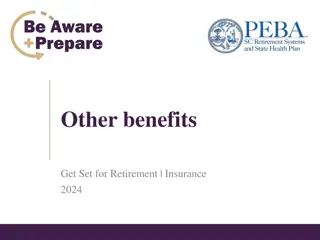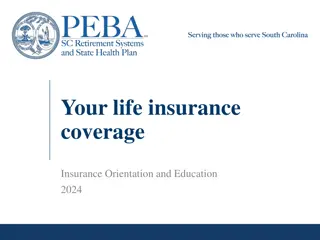Understanding Life Insurance Plans
Life insurance plans are essential financial products that offer protection and financial security to loved ones in the event of the insured's death. There are various types of life insurance plans, including whole life insurance and term insurance, each serving different purposes and offering unique benefits. Understanding the different variants and advantages of life insurance plans can help individuals make informed decisions to safeguard their family's future.
Download Presentation

Please find below an Image/Link to download the presentation.
The content on the website is provided AS IS for your information and personal use only. It may not be sold, licensed, or shared on other websites without obtaining consent from the author. Download presentation by click this link. If you encounter any issues during the download, it is possible that the publisher has removed the file from their server.
E N D
Presentation Transcript
Introduction To Life Insurance Plans
Meaning of product:- It is same as commodity, the term product comes from the term reproduce which means to bring forth or create. Products may be tangible (physical objects that can be touched) or intangible (that perceived indirectly). Life insurance is a product that is intangible.
Traditional Life Insurance Product:- Whole Life Insurance Plans Traditional Life Insurance Products Term Insurance Plans Endowment Insurance Plans
Term Insurance Plans:- It is only valid only during a certain period that has been specified in the contract. Purpose:- A Term life insured if dies prematurely there will be a sum of money available to take care of his loved one s. it also comes handy as an income replacement Plan. Disability Term Insurance as Rider Renewability Convertibility USP (Unique Selling Proposition):- Enabling one to buy relatively large amount of life insurance on a limited budget.it thus make good plan for the main income earner.
Variants:- Decreasing Term Assurance i. Mortgage Redemption ii. Credit Life Insurance Increasing Term Assurance Term Insurance With Return Of Premiums Relevant Scenarios:- i. mortgage redemption or for protection of a speculative investment. ii. Convertible term assurance may be suggested as an option where a permanent plan is non affordable. iii. Buy term and invest the rest philosophy, where the buyer seeks to but only cheap term insurance protection from the insurance company and invest resultant difference of premiums in a investment option elsewhere. Considerations:-
Whole Life Insurance:- It s an example of permanent insurance policy. In other words there is no fixed term to cover but the insurer offers ti pay the agreed upon the death benefit when the insured dies. No matter whenever the insured dies. The premium can be paid throughout one s life or for a specified period of time which is limited and is less than one s lifetime. Whole life premium are much higher than term premium. This policy is good plan for one who is the main income earner of the family and wishes to protect the loved ones.
Advantages of Whole Life Insurance:- Cost of premium paid never increases. In this premium paid towards increasing the cash value & your cash value earns interest similar to saving account. Cash value and death benefit never decreases until you start withdrawing cash value. It pays dividend which aren t taxed. Dividend can be utilized in the form of reinvestment and also to buy more life insurance. The policy holder can get loan from it and to pay interest to the insurance company but loan rate are very competitive with bank rate on home equity lines. The loan balance can be repaid at the time of death by deducting it from death benefit. Potential for tax income. A true long term investment.
Endowment Assurance:- A combination of two plans: A term assurance plan which pays the full assured in case of death of the insured during the term or a pure endowment if insured survives pays this amount at the end of the term. It is primarily a saving programme which is protected by provision of insurance against the contingency of premature death. It offers a safe and compulsory method of saving accumulating. This policy has also been promoted as a means for the profit saving.
Variants:- Participating (Par) or with profit plans Money back plan Par and non- par schemes
Dividend Method Of Profit Participation:- Portfolio method The total investment return on the company's portfolio was calculated, and all policyholders were credited with their portion of the divisible excess. There was no attempt to separate the function of earned return. Homogenized rates of return made them stable over time. It applied the principle of pooling of risks over time and is quite analogous in this respect to the uniform reversionary bonus mechanism. Current money method Here the return depends on when the investment was made and the rate that was secured at the time of investment. It s also called segmented or investment block method as different investment blocks gets different returns. The basic logic underlying the approach is the smoothing out of investment returns over time.
Riders in Life Insurance Plans:- A rider is a provision typically added though our endorsement, which then becomes part of the contract. Riders are commonly used to provide some sort of supplementary benefit or to increases the amount of death benefit provided by a policy. Riders can be the way through which the benefits lie disability cover, accident cover and critical illness cover can be provided as additional benefits in a standard life insurance contract. These riders may be availed of by the policyholder by opting for them and paying an additional premium for the purpose.
Different Life Insurance Riders:- Income benefits rides Wavier of premium Accidental death rider Critical illness Permanent and partial disability
Benefits Of Riders: Extra coverage Affordability Flexibility Tax benefits
Life Insurance Form And Procedures:- Moral hazard report
Documents Of Life Insurance Policy:- Policy Document Policy Schedule Standard Of Provision Specific Policy Provision Policy Stage Documentation First Premium Receipt























